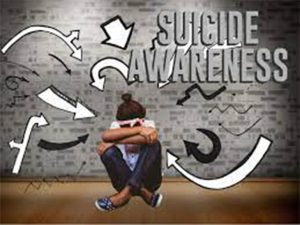Md. Arafat Rahman: Around one million people commit suicide in the world every year. According to the World Health Organization, suicide is the thirteenth leading cause of death worldwide each year. Suicide is the leading cause of death among adolescents and those under the age of thirty-five. The suicide rate is much higher among men than women. Men are three to four times more likely to commit suicide than women. Suicide is the act of intentionally giving up one’s own life or taking one’s own life.
Doctors consider suicide attempts to be a serious symptom of depression. Attempted suicide has already been declared a crime in many countries around the world. Assisted suicide is when a person helps another person to die by advice or indirectly by some other means. Here one person takes a more active role in another person’s death.
Suicide is often associated with mental illness. In Asia, rates of mental illness are much lower than in Western countries. Among those admitted to psychiatric units, many are at risk of full suicide. About half of those who die by suicide have major depression. In addition, another mental illness such as bipolar disorder increases the risk of suicide more than 20 times. Other conditions include schizophrenia, personality disorders, obesity-related disorders, and post-traumatic stress disorder. About 5% of people with schizophrenia commit suicide.
Countries with high alcohol consumption and high bar density generally have high suicide rates. Alcoholics who attempt suicide are usually male, older, and have attempted suicide in the past. Death by suicide among heroin users is about 14 times more likely than among non-users. Adolescents, who abuse alcohol, have neurological and psychiatric disorders that increase their risk of suicide.
Cocaine and methamphetamine abuse are highly associated with suicide. Those who use cocaine are at greatest risk during the withdrawal phase. Smoking is associated with increased risk of suicide. There is no evidence why it exists; However, it is assumed that people who like to smoke are also prone to suicide. The health problems caused by smoking motivate people to end their lives and smoking induces suicidal tendencies in the brain. 12 to 24% of gamblers attempt suicide. The suicide rate among those couples is three times higher than in the general population.
There is an association between suicidality and physical health problems, such as chronic pain, brain injury, cancer, kidney failure, HIV, and systemic lupus erythematosus. The subsequent risk of suicide often doubles after a cancer diagnosis. Depression and alcohol abuse lead to increased suicide rates. Sleep problems such as insomnia are thought to be a risk factor for suicide. In some cases, sleep problems can be a risk factor for depression. Several other medical conditions such as mental disorders, hypothyroidism, Alzheimer’s disease, brain tumors, and many medications can cause adverse effects.
Psychological conditions increase the risk of suicide: such as depression, loss of joy in life, and anxiety. Decreased problem-solving ability, loss of abilities that were previously present, and impairment in emotion regulation also play a role. Suicide due to which a person feels that he is not a part of society is basically known as egoistic suicide.
Recent life stressors such as the loss of a family member or friend, job loss, or social isolation such as living alone increase the risk of suicide. Those who are not married are more vulnerable. Being religious reduces the risk of suicide. Many religions stand against suicide. Among Muslims who are religious, the suicide rate is lower. Childhood sexual abuse and being raised in step-parent care also increase the risk of suicide. Sexual assault is thought to contribute about 20% of the overall risk.
Poverty is associated with suicide risk. Increasing poverty increases the risk of suicide around a person. The media, including the internet, plays an important role in suicide. Suicide narratives can have negative effects when accompanied by repetitive coverage, eulogizing or romanticizing. When detailing how to kill oneself in a certain way, this method of suicide can increase in the entire population.
Suicide methods vary from country to country. Leading methods in various regions include suicide by hanging, drinking poisonous pesticides and using firearms. A review of 56 countries found that hanging was the most common method of suicide in most countries, with 53% of male and 39% of female suicides. 30% of suicides worldwide occur from pesticide poisoning, most of which occur in the developing world. In many countries about 60% of women and 30% of men commit suicide through drug abuse.
Through careful observation and research, it can be seen that 87% to 98% of suicides occur due to mental imbalance. In addition, other factors are interrelated with suicidal risk. Among them – drug addiction, lack of purpose in life, family tradition of suicide or previous head injury are major factors.
Factors such as unemployment, poverty, homelessness and discrimination in the socio-economic context encourage suicide. Poverty is not directly linked to suicide. But, increasing it increases the risk of suicide and puts individuals at higher risk of suicide due to anxiety. A history of childhood physical or sexual abuse or passing time through strict control, are also considered risk factors. Nowadays, the tendency to commit suicide due to failure in love or death of a loved one is on the rise. Due to family or society not recognizing the joint suicide of lovers is also happening often.
Modern medical science has identified suicide as a mental illness. It is possible to get rid of this by taking proper treatment. When a person begins to have extensive suicidal thoughts, they should be taken to a doctor immediately. Individuals who suffer from anxiety are among the highest risk groups for suicide. In developed countries there are crisis hotlines where concerned people report their suicidal thoughts and plans. By using the hotline, the victim is informed about the solution to his problem and keeps himself free from suicide. According to the World Health Organization, self-love is considered one of the most important factors in preventing suicide.
Suicide prevention is a collective effort to reduce the incidence of suicide through preventative measures. Measures include the use of safety belts on bridges and subways. Treating drug and alcohol addiction issues can also be effective in people with depression and those who have attempted suicide in the past. Alcohol access can be reduced as a preventive strategy. Behavioral therapy is promising for young adults who have recently thought about suicide. Reducing poverty through economic development can reduce suicide rates. Efforts to increase social connections may be effective in older man.
Author: Md Arafat Rahman is a columnist and service holder at Southeast University. He can be reached at E-mail: arafatrahman373@gmail.com








